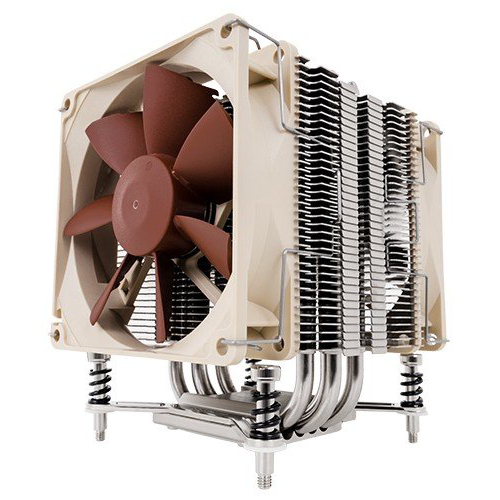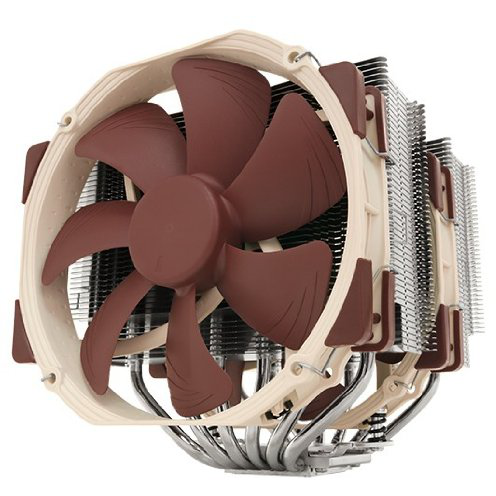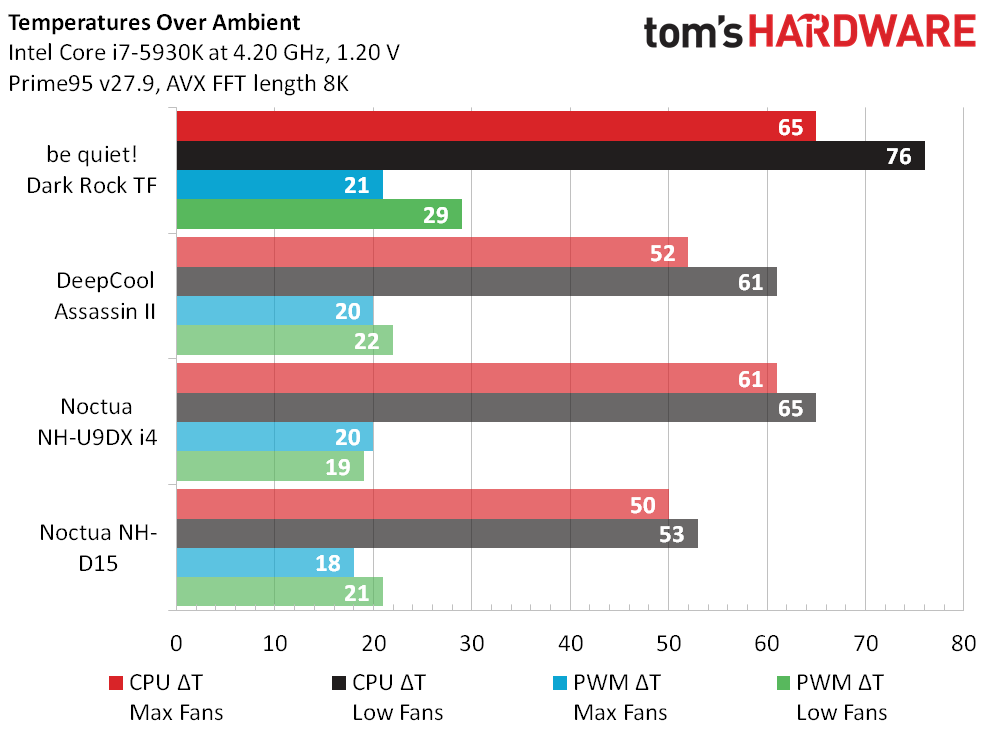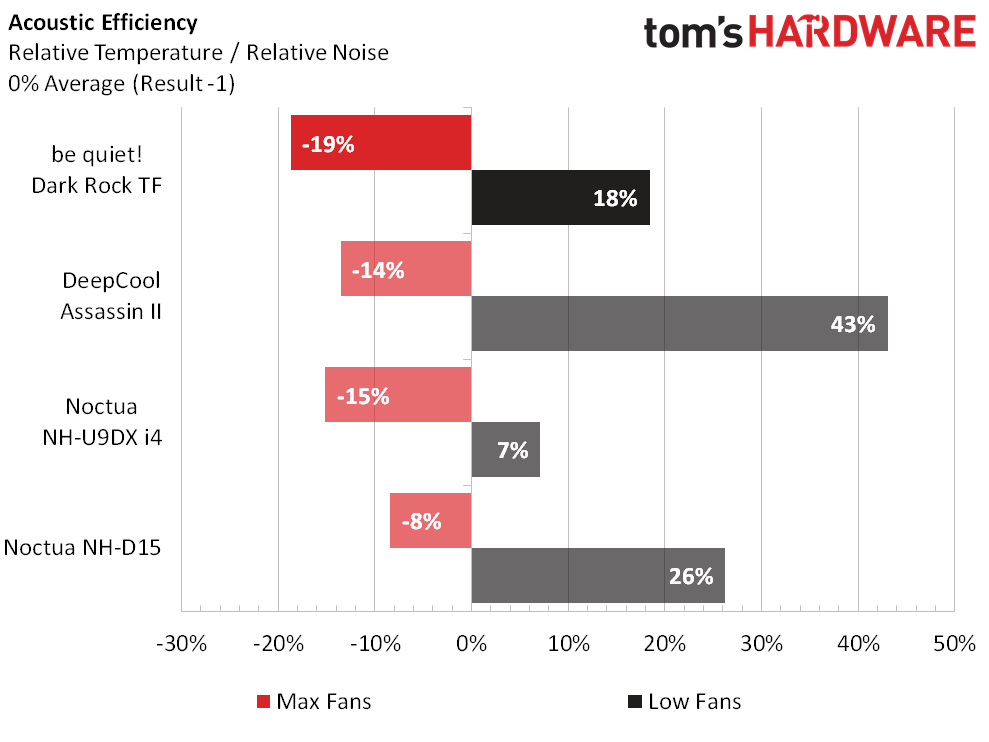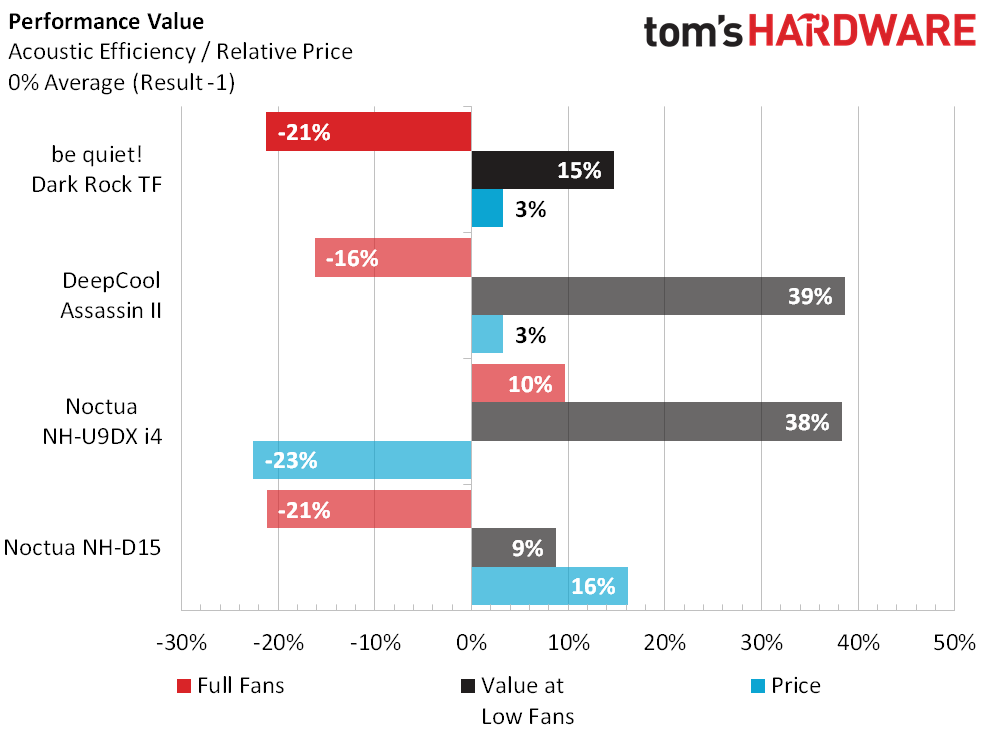be quiet! Dark Rock TF Review
Can a mid-height downdraft cooler keep up with our overclocked Haswell-E CPU? We put the Dark Rock TF by be quiet! through our tests to find out.
Why you can trust Tom's Hardware
Test Results & Conclusion
Comparison Coolers
Test Results
The Dark Rock TF may be unique among our tested downdraft coolers in scale, but that doesn’t mean there weren’t any other coolers of this height to compare to. The server-oriented NH-U9DX i4 stands 0.1” shorter than the Dark Rock TF, and though it also has tiny fans, it performed excellently in its review. It even outpaced the Dark Rock TF's thermal performance, though we expect server-oriented coolers to have some noise issues.
The Dark Rock TF’s fans run slightly below the rated RPM, due to resistance of the sink fins and backpressure from the motherboard they face. Turning the motherboard’s PWM-based fan controller to 50% duty cycle, we see that the lower air pressure allows them to run faster than 50% of the rated speed.
The Dark Rock TF is quieter than any other cooler in this comparison, and that could give it a competitive cooling-to-noise ratio as well as making it a reasonable choice for quiet environments. It spun down to produce only 19.1 decibels at 1m (calculated) when the motherboard’s fan controller was set to 50% duty cycle. The similarly tall NH-U9DX i4 produced only slightly more noise, and the included resistor wire didn’t spin it down as much.
Looking at the big-fan coolers, the Dark Rock TF has the same price as the Deepcool Assassin II and a 5% worse cooling-to-noise ratio at full speed. It’s even beaten by the tiny NH-U9DX i4, which in turn gets its improved cooling-to-noise ratio from better cooling rather than lower noise.
The Dart Rock TF can’t match the value of the DeepCool Assassin II, but that’s not really a fair comparison since the shorter downdraft cooler is designed to fit more cases. Unfortunately, it also loses to the even smaller NH-U9DX i4. And that might not be a fair comparison at “low” fan speed, since I used Noctua’s resistor wires rather than 50% PWM setting. I did this because I always want to include the manufacturer-supplied fan control in the results, whenever provided. The cost of controllers is part of the price of the product, after all.
Without resistor wires and the motherboard’s fan controller set to 50% duty-cycle, the NH-U9DX i4 allowed CPU temperature to rise to 75° above ambient (Dark Rock TF was hotter at 76°). Sound pressure level dropped to 18.8 decibels (Dark Rock TF was louder at 19.1 dBA), the cooling-to-noise ratio rose to 22% above average (Dark Rock TF was worse at 18%), and NH-U9DX i4 value rose to an incredible 58% above average. Half of that extra value is due to a 25% lower price.
Of course the NH-U9DX i4 does have a few shortcomings, such as its inability to support anything other than the square and narrow ILM version of Intel’s LGA 2011 (including v3). Noctua sells a completely different model called the NH-U9B SE2 for other form factors, yet our review of the NH-U9DX i4 showed that these two products differ only in their mounting kits. That is to say, Noctua’s customers need two different model numbers to figure out what to buy instead of the Dark Rock TF from be quiet! What does this all mean for the Dark Rock TF?
Get Tom's Hardware's best news and in-depth reviews, straight to your inbox.
Conclusion
Entering the review process with the assumption that a product will win our stamp of approval, I lose that enthusiasm only when that product comes up significantly short of competing samples. The lack of any similar capacity downdraft coolers to compare should have made it easy for the Dark Rock TF to reach that mark, yet today’s review showed that a 92mm cross-draft cooler can beat a 135mm downdraft cooler in temperature, noise, price and size.
MORE: Best Cooling
MORE: Best CPUs
MORE: Best CasesMORE: All Cooling Content
Thomas Soderstrom is a Senior Staff Editor at Tom's Hardware, covering Cases, Cooling, Memory and Motherboards. Follow him on Twitter.
Subscribe to Tom's Hardware on Facebook and Google+, RSS, Twitter and YouTube.
-
unixwizard I am not certain from the information in this article how the testing was conducted, but I have some serious concerns that the information given here doesn't paint a whole picture of real world effects.Reply
Lets take one example: Many articles on air and water coolers note that airflow over VRMs and other MB components could be significantly different, yet I never see readings of MB temps, VRM temps, or anything other than CPU. How much of an effect is it? Show the data.
Likewise, as you mention in text, a cooler like this could perform best when it can vent air directly out the side of a case. You lack any data showing this however. As far as I can tell, the usual rigor for testing isn't applied to coolers.
In my opinion you should test coolers in a handful of configurations. Maybe pick some of the most popular cases or best performing cases in a handful of configurations and use these as a standard. An open test bench is the one configuration that you should never use, since it will never be similar to an actual usage scenario. Feel free to focus on only a few scenarios, like 'big high airflow case for overclocking to the max on air", and "balanced temp/noise performance in a mid-sized size vented case", and "space restricted case with little venting" or whatever, but once you pick the scenarios, please report more than just CPU temp and noise. Report VRM temps, chipset temp, RAM temp, and use a couple temp probes to measure exhaust temp out the side/back, etc. Better yet, show some thermal images of the cooler/MB in operation if you can. Also, make sure you let the case/system 'heat soak' under load so we know how it works under sustained load rather than just a quick heat pulse.
Do this for a few coolers of differing type and see if the picture changes or more is revealed with this method. If it isn't then at least you'll have data to say that more detailed reporting doesn't create a different picture, but I have a suspicion that differing coolers will change positions considerably in the various scenarios, revealing strengths and weaknesses that matter to people looking to buy them for the specific scenario tested.
As an example, I own a Lian-Li V2000B and a Rosewill Throne, both large cases but very different in scenario. The V2000B is a sealed through-flow case with no side vent and the Throne is side/top vent with little airflow out the back. The cooler in this article might work wonders in the Throne, perhaps even better than the other coolers, and be terrible in the V2000B.
Just my 2 cents, but I don't feel I get enough out of these cooler articles to make a good purchase decision. -
Crashman Reply
In a complete machine. It appears the site removed this information, so here's an earlier article that contains it:16949552 said:I am not certain from the information in this article how the testing was conducted,
http://www.tomshardware.com/reviews/deepcool-gamer-storm-captain-240-liquid-cpu-cooler,4158.html
Do tell!16949552 said:but I have some serious concerns that the information given here doesn't paint a whole picture of real world effects.
This review discusses the same issues. Perhaps you didn't read the text? It also charts the voltage regulator temperature. Perhaps you didn't read the chart legend?16949552 said:Lets take one example: Many articles on air and water coolers note that airflow over VRMs and other MB components could be significantly different, yet I never see readings of MB temps, VRM temps, or anything other than CPU. How much of an effect is it?
PWM means Pulse Width Modulator, which is a far-more-accurate name than "Voltage Resistor Module". This measurement is shown in the chart and discussed below the chart.
We did. Sorry you missed it.16949552 said:Show the data.
Thats because we haven't found a specific case to fit every specific cooler. The generic statement about a downflow fan working best when it can draw air through the side panel comes from prior experience with cases designed specifically for that purpose, but cases aren't designed that way any longer. It's mention as a suggestion to people able to find such a case, or modify it appropriately16949552 said:Likewise, as you mention in text, a cooler like this could perform best when it can vent air directly out the side of a case. You lack any data showing this however.
Cooler tests take less time than motherboard tests, but is that really a problem? We've attempted to create the "most generic" airflow configuration for the case and even tested the cooler at max/min CPU fan setting to show its operating range.16949552 said:As far as I can tell, the usual rigor for testing isn't applied to coolers.
-
photonboy My beef:Reply
I always find reviews for CPU coolers difficult to decipher. Different fan speeds, noise, cooling arrrggh.
*What I personally want is a simple chart showing cooling performance at say a total 35dB for the system or whatever.
Go ahead and include whatever charts you want, but I'm about cooling-to-noise ratio and that needs to be easy to find. -
Crashman Reply
I know it's not the easiest thing to decipher, but the cooling-to-noise chart is in there.16950852 said:My beef:
I always find reviews for CPU coolers difficult to decipher. Different fan speeds, noise, cooling arrrggh.
*What I personally want is a simple chart showing cooling performance at say a total 35dB for the system or whatever.
Go ahead and include whatever charts you want, but I'm about cooling-to-noise ratio and that needs to be easy to find.
It shows how much better or worse each cooler's result was compared to the average of all tests.
-
milkod2001 Nice review. Looks like Noctua is still the way to go.Reply
On the side note: Could you guys do tests of some PCspeakers. Im looking for replacement of my Logitech Z 2300. Im looking for something what could match it price/performance wise. Would anyone had some recommendations?
Thanks -
firefoxx04 Overpriced. I dont care if it is smaller than the D15 and Phanteks dual 140mm cooler.., its not worth that much more.Reply -
firedust You mentioned that the review includes voltage regulator temperature. I must be blind because I can't find it anywhere. Is it the first graph?Reply -
Crashman Reply
Yep, PWM is Pulse Width Modulator as described where you saw me say it above.16959459 said:You mentioned that the review includes voltage regulator temperature. I must be blind because I can't find it anywhere. Is it the first graph?
https://www.youtube.com/watch?v=DWZYS4-09wo

